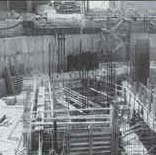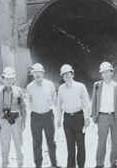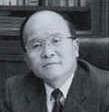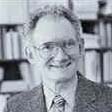
Members of the U.S.-side panel investigated the damages resulting from the 1994 Northridge Earthquake. A brief summary is provided based on a paper by H.S. Lew of the National Institute of Standards and Technology, James Cooper of the Federal Highway Administration, Samuel Hacopian of the U.S. Department of Housing and Urban Development, Walter Hays of the U.S. Geological Survey, and Michael Mahoney of the Federal Emergency Management Agency.
The magnitude 6.8 earthquake that occurred during the pre-dawn hours of January 17, 1994, centered under the community of Northridge in the San Fernando Valley of California, provided a crucial test for assessing the progress made in earthquake resistant design and construction since the San Fernando earthquake in 1971, which was of a similar magnitude.
A reconnaissance team was organized by NIST through the auspices of the National Earthquake Hazards Reduction Program and the Interagency Committee on Seismic Safety in Construction to observe the damage, assess the performance of various types of engineering structures, and document the effects of the earthquake on the built environment: buildings, bridges, and lifeline systems.
Because the earthquake occurred early in the morning on January 17, a federal holiday (Dr. Martin Luther King Day), most non-residential buildings were empty and traffic was extremely light. These fortuitous circumstances greatly helped limit the number of deaths and injuries; 58 deaths have been attributed to the earthquake and about 1,500 people suffered major injuries. Estimates of the number of people temporarily or permanently displaced because of damage to their houses or apartments ranged from 80,000 to 125,000. Total loss from this earthquake was estimated to reach $30 billion, the costliest earthquake in U.S. history.
The earthquake provided the first full scale "test" of modern (post 1970s) seismic building codes in the United States. For the first time, a large and varied population of buildings was subjected to ground shaking equal to or exceeding that recognized in modern codes for design.
The building damage caused by the 1971 magnitude 6.6 San Fernando earthquake prompted significant revisions to earthquake design requirements. As a result, the 1976 Uniform Building Code (UBC) is often specified as a "benchmark" code that ushered in "modern" seismic design methods (FEMA 154, 1988). Comparisons of building response in the 1971 and 1994 earthquakes give some insight into the efficacy of earthquake mitigation practices that have been undertaken in the Los Angeles area in the intervening years.
Of the 58 deaths attributed to the earthquake, 22 were caused by the structural failures of buildings. Schools, hospitals, offices, stores, and other commercial and industrial enterprises were forced to close due to damage, much of it nonstructural. Viewed in this light, the earthquake demonstrated the limitation of modern building codes. Steel moment-resisting frame buildings suffered severe unexpected damage in the earthquake. Approximately 100 buildings experienced fractures in the welded beam-to-column joints. While none of the steel frame structures collapsed or caused serious injury to their occupants, their damaged condition leaves them vulnerable to future earthquakes. Considerable effort by the engineering and research communities is being directed to develop and validate repair procedures for existing damaged structures and design methods for new construction.
The vast majority of bridges in the area performed well. However, the earthquake caused the collapse of six major highway bridges and heavy damage to 157 other high bridges. The estimated cost to replace or repair these bridges is $1.5 billion. Those bridges designed using standards developed after the mid-1970s performed well. Most older bridges which had been seismically retrofitted performed well also.
Most of the failed natural gas lines were of pre-1971 construction. Compared with the 1971 earthquake, this earthquake resulted in more ruptures in the distribution lines than in the transmission lines. Most of the breaks occurred to old steel pipes. Plastic pipes used in the distribution system seemed to perform well.
Power was lost to most of the Los Angeles basin area after the earthquake. Of the 2 million customers who lost service immediately, half had power restored within one day, and over 95 percent had power restored by midnight, January 18. All power was restored within 10 days after the earthquake.
All airports in the region survived the earthquake with no major problems. There was a 25 freight car derailment in Northridge during the earthquake, resulting in the spill of 30,000 liters of sulfuric acid and 7,500 liters of diesel fuel. There were no casualties. About 200 meters of railroad tracks were replaced immediately following the earthquake, and rail service was restored on January 19. In general, fire sprinkler systems designed and installed in accordance with the latest seismic standards withstood the earthquake with little damage. However, in some instances, sprinkler pipes ruptured where sprinkler systems interacted with suspended ceilings.
The following is a summary of a paper authored by Riley M. Chung of the National Institute of Standards and Technology.
An earthquake measuring 7.8 on the Richter scale struck northern Japan at 9:17 a.m., EDT, Monday, July 12, 1993. Its epicenter was located about 80 km west of Hokkaido Island. Total life loss reached 231, caused mostly by the tsunamis and fires. Total loss was estimated at $1 billion.
Immediately after the earthquake and under the auspices of the U.S.-Japan Panel on Wind and Seismic Effects, the United States dispatched a team to jointly investigate the impact of this earthquake to the built environment. The team stayed in the field for about one week, teaming up with a Japanese team led by the Public Works Research Institute. The earthquake provided an opportunity to study the performance of wood-framed buildings, the causes of and response to fires, the effect of tsunamis, and the performance of lifelines and other infrastructure systems.
Damage to the built environment was primarily caused by tsunamis, fires, landslides, and ground failures (i.e., liquefaction, sand boils, and lateral spread). Okushiri, a small island off the coast of Hokkaido and 48 km south of the epicenter, was devastated by the fires, tsunamis, and landslides.
The study team members were impressed by what they had learned during the post-event investigations. In all respects, the event demonstrated the well-prepared nature and resilience of the Japanese community.
In general, shaking damage to buildings on Hokkaido and even on Okushiri Island was light to nonexistent, while tsunami damage on Okushiri Island varied, from total loss for wood buildings severely inundated to moderate for concrete or steel buildings well anchored to their foundations.
Several bridges suffered minor damage as a consequence of liquefaction-induced ground displacements. The most common disruption of bridge sites was settlement of the approach fill due to compaction of the embankment materials.
The town of Aonae, a fishing village of about 1,600, experienced the only known fire ignitions as a result of the earthquake. The fires eventually consumed 190 houses and buildings over an 11-hour period. The principal mechanisms of building-to-building fire spread involved ignition of exterior wood trim, radiant ignition of combustible contents through windows, burning spread along scrap wood between buildings, and the burning of kerosene and propane tanks.
Water supply to Aonae was not affected and structural performance of the Aonae Sewage Treatment Plant did well during the earthquake. However, the sewage treatment plant was shut down following the earthquake as the result of contamination by seawater of pumps, motors, electrical equipment, etc., located in a pump room below grade.
Electric power does not appear to have been significantly impacted. Highways performed well with most damage to pavements resulting from general ground settlement and settlements at approaches to bridge abutments. Kilometers of flood-control dikes along rivers in southwestern Hokkaido were damaged due to liquefaction of subsurface sediments.
The 26th Joint Meeting of the Panel on Wind and Seismic Effects was held May 17-20, 1994, at the National Institute of Standards and Technology (NIST) in Gaithersburg, Maryland, U.S.A.
The panel is one of 16 panels in the U.S.-Japan Conference of Development and Utilization of Natural Resources (UJNR), which was first convened in 1964. The Wind and Seismic Effects Panel was established in 1969.
The principal objectives of the panel are to provide opportunities for exchanging research results related to the revision of design criteria and for developing comprehensive measures and technical efforts to reduce the loss of lives and property from violent winds, earthquakes, storm surges, and tsunamis.
Seventeen U.S. and seven Japanese agencies participate with representatives of private sector organizations.
Technical sessions were held on the following subjects: Wind engineering, Earthquake engineering, Storm surge and tsunamis, Joint cooperative research programs, and Northridge, California and Hokkaido Nansei-oki earthquakes.
The Panel's activities have resulted in improved building and bridge standards and codes, and design and construction practices in hydraulic structures in both countries.
During the week following the 26th Joint Meeting of the Panel on Wind and Seismic Effects in Gaithersburg, Maryland, U.S.A. in May 1994, Japanese and U.S. members of the panel visited the following eight technical sites at five locations across the United States.
1. National Institute of Standards and Technology (NIST)
On its visit to NIST in Gaithersburg, Maryland, the delegation was provided an overview of NIST's Building and Fire Research Laboratory (BFRL); tours of BFRL's structures, materials, environmental, and fire facilities; NIST's Research Reactor and its Cold Neutron Research Facility at its Materials Science and Engineering Laboratory; and an overview of NIST's Advanced Technology Program.
2. Massachusetts Institute of Technology (MIT)
The delegation visited MIT's Center for Construction Research and Education (CCRE) in Cambridge, Massachusetts. CCRE provides civil engineering research and education directed at helping construction firms identify barriers to improving their construction practices and recommending methods to resolve barriers.
3. Central Artery Tunnel Project 
The delegation investigated advanced design and construction technologies at the construction site for the 3rd Boston Harbor Tunnel. This construction project will replace Boston's 40-year-old elevated Central Artery with a widened and mostly underground 8 to 10 lane interstate highway through downtown Boston and an east/west Seaport Access Road tunnel through south Boston to Logan International Airport.
4. Deer Island Treatment Plant
In the 1980s, the harbor in Boston, Massachusetts, was one of the most polluted in the United States. In 1985, the Massachusetts Legislature created the Massachusetts Water Resource Authority (MWRA) to supply water and sewage services to 61 Boston-area cities and towns (more than 2 million people) and to improve the water quality of the harbor. The Deer Island facility at the mouth of Boston Harbor studied by the delegation will be a 4.81 million cubic meter per day plant, the second largest facility of its kind in the United States.
5. Virginia Polytechnic Institute and State University
At the Virginia Polytechnic Institute and State University in Blacksburg, Virginia, the delegation discussed studies performed by the Center for Intelligent Material Systems and Structures, the Fiber and Electro-Optics Center, and the Center for Construction Engineering.
6. Waterways Experiment Station
At its visit to the U.S. Army Corps of Engineers' Waterways Experiment Station (WES) in Vicksburg, Mississippi, the delegation viewed construction of the world's largest centrifuge at the WES Geotechnical Laboratory. It has a radius of 6.5 m, a maximum payload at 350 g of 2000 kg, and a maximum g-force of 1,144,000 kg. It is scheduled to be in operation in early 1995. At WES' Information Technology Laboratory (ITL) the delegation studied ITL's virtual reality work. In WES' Structures Laboratory, the delegation viewed computer-based analytical modeling which is used in solution of many infrastructure problems.
7. Damage Sites from the Northridge Earthquake
At the State of California's Transportation (CALTRANS) District 7 Office the delegation studied CALTRANS repairs to damaged bridges and highways from the Northridge Earthquake in early 1994.
8. Seven Oaks Dam Project 
The U.S. Army Corps of Engineers hosted the delegation's studies of this earth/rock fill dam site in Seven Oaks, California, that will control the flood plain downstream of the Santa Ana River. Flood water will be diverted, as needed, into an open space below the dam to provide a natural floodway and diverted into a wildlife habitat corridor.

The Japan-side Panel is composed of membership from seven Japanese government
agencies and experts from academia and public and private organizations. The
government agencies include the Public Works Research Institute which chairs the
Japan-side Panel, the Building Research Institute, and the Geographical Survey
Institute of the Ministry of Construction; the National Research Institute for
Earth Science and Disaster Prevention of the Science and Technology Agency; the
Port and Harbor Research Institute and the Meteorological Research Institute of
the Ministry of Transport; and the Civil Engineering Research Institute of the
Hokkaido Development Bureau of the Hokkaido Development Agency. 
The Public Works Research Institute (PWRI) provides the Japan-side Chair and the Secretary-General who is responsible for managing its day-to-day administrative activities. This role is similar to that performed by the National Institute of Standards and Technology which manages the U.S.-side Panel.
PWRI is Japan's civil engineering laboratory and the largest in Japan. PWRI's mission is to research and develop improved construction technologies for a better environment and quality of life. The Institute is composed of 11 Departments, a Construction Management Engineering Center, and an Experimental Laboratory at Niigata. They conduct fundamental and applied research in areas such as earthquake disaster prevention; dam construction; environmental technologies; road and traffic engineering; river management and water quality control; design, construction, and maintenance of bridges; construction equipment and materials; erosion control; and in areas of new frontier technologies such as underground development and advanced technology.
Extensive research is performed in advanced construction technologies using robots and prefabrication technologies, e.g., lightweight materials for bridges. Emphasis is being given to exploring next generation projects such as ultra long span bridges that exceed lengths of the 4 km Akashi-Kaikyo suspension bridge, developing technologies for offshore facilities and for designing and constructing public work facilities 60 to 200 m underground.
The Institute has over 70 facilities. Examples of unique facilities relating to Panel activities include its Structural Engineering Laboratory's 30 MN universal testing machine; Vibration Laboratory; Earthquake Engineering Laboratory; Boundary Layer Wind Tunnel (largest in the world) with a test section of 41 m x 4 m x 30 m where a 1:100 scale model of the 4 km Akashi-Kaikyo suspension bridge was tested.
Great emphasis is placed on promoting international research collaborations between developed and less developed countries through partnerships to perform joint research and technology exchanges.
PWRI was created in 1921. Today, its operating budget is over $100 million. It has more than 470 employees; two-thirds are engineering staff and one-third administrative staff.
National Science Foundation
In recent years, researchers from diverse disciplines have been drawn into vigorous efforts to develop intelligent materials or structures that can monitor their own condition, detect impending failure, control damage, and adapt to changing environments.
Under the direction of researchers at the National Science Foundation (NSF) the potential applications of such "smart" materials/systems are being explored.
Current research activities aim at understanding, synthesizing, and processing material systems which behave like biological systems. The United States, Japan, and industrialized Western European countries are leading in the fundamental research on smart materials and smart systems.
NSF has provided grants for work by independent researchers to the University of Illinois, University of Michigan, Lehigh University, Brown University, and the University of California-Berkeley.
For further information contact Dr. Ken Chong, Program Director, Mechanical & Structural Systems, or Dr. Shi Chi Liu, Program Director, Structural Systems, National Science Foundation, 4201 Wilson Boulevard, Arlington, VA 22030; telephone numbers (703) 306-1361 and (703)-306-1362, respectively, or facsimile at (703) 306-0291.
Federal Emergency Management Agency
FEMA is developing Guidelines for the Seismic Rehabilitation of Buildings and Commentary, which are intended to fill a gap in the National Earthquake Hazards Reduction Program (NEHRP) on the seismic safety of existing buildings. The guidelines are scheduled for completion in the fall of 1997.
This publication will contain a comprehensive set of nationally applicable and consensus-backed technical criteria (with commentary) on how to rehabilitate buildings so that they will better withstand earthquakes.
For further information contact Ugo Morelli, Policy Manager for Seismology, FEMA, 500 C Street, S.W., Washington, DC 20472; telephone (202) 646-2810 and facsimile (202)-646-3104.
Department of Housing and Urban Development (HUD)
HUD's Office of Policy Development and Research (PD&R) has initiated a contract with Steven Winter Associates and the National Conference of States on Building Codes and Standards (NCSBCS) to analyze the performance of earthquake-resistant bracing (ERB) systems for manufactured housing in the January 17, 1994, Northridge earthquake. This one-year project will also develop guidelines for retrofitting existing manufactured homes and installation standards for new homes in seismically active areas.
PD&R also is funding two separate damage assessment studies of the Northridge earthquake. One, being conducted by NIST, looks into the performance of multi-family and multi-story public housing. The second study, being conducted by the National Association of Home Builders, assesses the damage to single family homes.
HUD's Office of Housing recently engaged Wiss, Janney & Elstner and NCSBCS to assess damage and determine causes of failures and fires in manufactured housing.
For further information contact G. Robert Fuller, Senior Environmental Specialist, Office of Housing, HUD, Washington, DC 20410-8000; telephone (202) 708-1104, extension 2273; facsimile (202) 708-2387.
References for articles on Northridge and Hokkaido-Nansei-Oki Earthquakes
The 4th U.S.-Japan International workshop on remedial treatment of liquefiable soils was held on July 4-6, 1994, at the Public Works Research Institute (PWRI) in Tsukuba City, Japan. A technical tour of earthquake engineering practice at sites in and around Tokyo was given by the Japanese hosts on July 7-8.
The workshop was organized by Task Committee (H) on Soil Behavior and Stability During Earthquakes of the Panel on Wind and Seismic Effects. The workshop was supported by the PWRI and the U.S. Army Corps of Engineers' Waterways Experiment Station, Repair, Evaluation, Maintenance and Rehabilitation Research Program. Partial financial support was provided by the Tsukuba Science Foundation.
The workshop objectives were to exchange knowledge and experience among U.S., Japanese, and other international experts on foundation remediation against soil liquefaction and on the occurrence and behavior of liquefiable soils.
Soil liquefaction is an important factor in earthquake disasters and effective and reasonable countermeasures against the event must be developed and investigated. Although various types of remedial treatment methods have been investigated, developed and applied in practice in the United States and Japan, the specifications and standards for selecting methods have not been well established. This workshop allowed researchers and practitioners to leverage research investment in remediation technology and the best use of complementary strengths of international practice, knowledge, and research capabilities.
1995 Calendar of Events
| January 17-19 | 2nd Workshop on Wind and Earthquake Engineering for Off-Shore & Coastal Structures, Technical Committees K & I, Berkeley, CA., USA |
| March 13-15 | 6th Workshop on Earthquake Disaster Prevention for Lifeline Systems, Task Committee F, Irvine, CA, USA |
| May 25-31 | 11th Bridge Engineering Workshop, Task Committee J, Tsukuba, Japan |
| May | 2nd Workshop on Structural Control and Intelligent Materials Systems, Task Committees C & G. Held in conjunction with the 27th Joint Meeting, Tsukuba, Japan |
| May 16-19 | 27th Joint Meeting of the Panel on Wind & Seismic Effects, Tsukuba, Japan |
| May 20-27 | Panel's Technical Site Visits follow the 27th Joint Meeting |
| Fall 1995 | Workshop on State-of-the-Art Review of U.S.-Japan Research on Dam Earthquake Engineering, USA |
| Early 1996 | Workshop on Strong-Motion Data/Local Site Effects, Japan |
| April 1-2, 1996 | 4th Workshop on Storm Surge and Tsunamis, Hilo, Hawaii, USA |
Editor: Noel J. Raufaste, Secretary-General, U.S.-side, Head, Cooperative Research Programs,